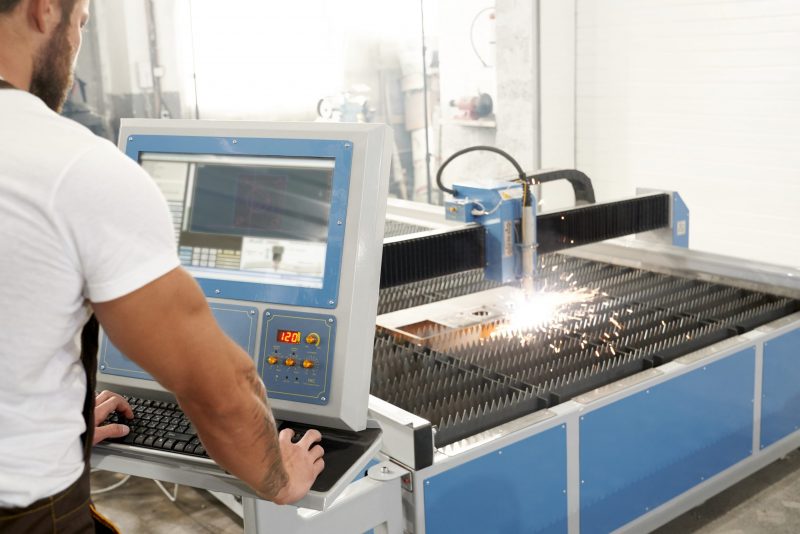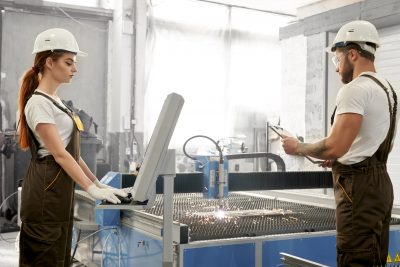
When it comes to metal fabrication projects, multiple methods are available to cut, shape, and bend large pieces of sheet metal into parts or products. Determining the best method for the desired result can be a challenge. Furthermore, the best tools or techniques depend on the fabrication types required. When examining the different metal fabrication services available, one option that will likely pop up is plasma metal cutting.
Plasma cutting has grown in popularity due to technological advancements in the process. Therefore, plasma cutting can tackle a range of projects and metals that older cutting tools often need assistance.
However, before starting a Google search for “metal fabrication companies near me” and choosing a metal fabrication service that appears to be able to tackle the job at hand through plasma cutting, it’s important to understand the plasma metal cutting process. Additionally, it’s vital to know how it differs from other cutting processes and whether it’s the best option for your business’ manufacturing projects and requirements.
Understanding Plasma Cutting for Metal Fabrication
Plasma cutting may have had a sudden jolt in popularity in metal fabrication, but the process has been around for quite a few decades. Plasma cutting evolved from plasma welding in the 1960s and was utilized as a productive way to cut sheet metal in the 1980s. At the time, it provided a new way to produce cleaner cuts than oxyfuel cutting. However, the early plasma cutting machines were big, slow, and expensive. As a result, it made them most efficient for mass-production projects by large companies and corporations.
How Plasma Cutting Works
Today’s modern plasma cutting machines use some of the same technology as other cutting options. When it comes to advanced metal laser cutting machines, the specification of a metal fabrication project is crucial.
Modern plasma cutters use CAD software to create these guidelines for the cuts required for each part or product. Therefore, the process can be repeated again and again without alterations or human intervention.
Once the instructions are electronically fed into the machine, the plasma cutter creates an energy-gas reaction directing a jet of ionized gas, called plasma. This is performed through a nozzle onto a workpiece to create the desired cuts. Operated by a computer numerical control (CNC) machine, the cuts are continually orchestrated, as many times as needed, to tackle large production projects.
Unlike older cutting methods, which tend to be a metal-on-metal cutting process, plasma cutting doesn’t rely on force or mechanical pressure to perform the required cuts. As a result, the process generally results in cleaner and more precise cuts with fewer errors along the way.
What Are the Advantages of Plasma Cutting in Manufacturing?
There are several benefits to plasma cutting as opposed to older or more traditional cutting methods for metal fabrication, which include the following below.
Better efficiency and speed
The involvement of CNC laser cutting and the streamlined process of plasma cutting means that large projects can be tackled continuously without interruption. As such, because of these computer-guided instructions, parts can be produced at high levels of precision and a fast rate of speed from start to finish.
More versatility when it comes to metals
One of the most significant benefits when it comes to plasma cutting is the type of metals that can be handled with relative ease. Plasma cutters are best known for their ability to cut through thick, tough metals that can be harder to cut via traditional cutting machines, like stainless steel, brass, and copper. As a rule of thumb, plasma cutters can handle metal thicknesses up to 300 mm for aluminum or 200 mm for steel. Therefore, plasma cutting is a better option for more challenging manufacturing projects requiring tougher raw materials.
A lower minimal heat affected zone (HAZ)
Plasma cutting is known for creating a minimal heat affected zone (HAZ), which can have a range of benefits. For one thing, older cutting methods like oxyfuel cutting generate a more intensive HAZ. This increases the risk of thermal stress and mistakes or distortions in the workpiece. A smaller HAZ means that the materials’ inherent properties are better preserved, which in turn leads to better precision when it comes to intricate cuts.
The Disadvantages of Plasma Cutting in Manufacturing
While there are notable benefits to plasma cutting, there are a few drawbacks including the following.
Lower precision than modern laser cutting machines
While plasma cutting can be very precise, especially for basic cuts, it’s not as precise as other cutting methods like modern laser cutting machines due to the inherent melting process involved. As such, it might not be the best option for projects requiring detailed cuts or the highest level of precision for the products or parts to meet specifications.
Post-processing and finishing are often required
Once the plasma cutting process is complete, mitigating any alterations due to the melting and cutting process is important. Additionally, finishing is often required to ensure the parts have no rough edges or distortions. After plasma cutting, many parts and products may require final steps before completing the project. Some of these finishing stages include:
- edge dressing
- bending
- deburring
- painting
- powder coating
This can be time-consuming and can also increase the overall cost of a mass-production project.
Choose the Right Partner for All Plasma Cutting and Metal Fabrication Projects
There are so many options for outsourcing your metal fabrication projects. However, before choosing a metal fabrication services provider, your first step should be a conversation with an expert. Our team can help you understand the various methods, tools, and capabilities available.
At Steelway Laser Cutting, we’re standing by to start a discussion about your unique manufacturing or cutting needs. Our team of experts knows how to make your life easier, regardless of if you need a hand with a smaller project or need to routinely tackle high-volume orders of 1000+ units per project or more.
Discover how our expert team at Steelway Laser Cutting can make your operations better, more productive, and more cost-effective. With an expert in metal fabrication like Steelway Laser Cutting leading the way, you can rest assured that you’ve selected the best metal cutting process for your unique manufacturing needs.
Article reviewed and approved by Director of Product Design – Derek McAvoy.

